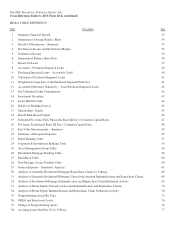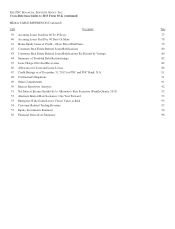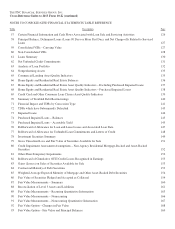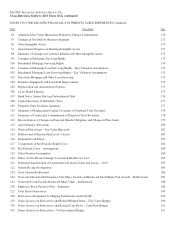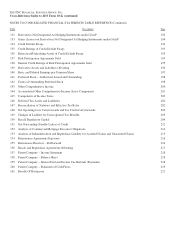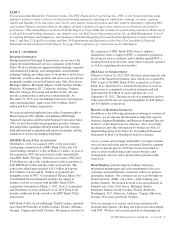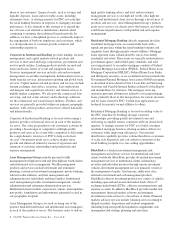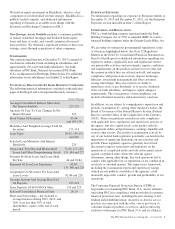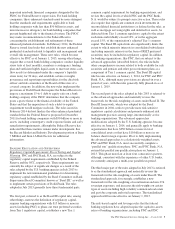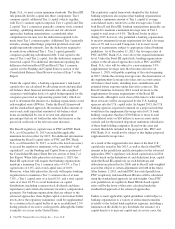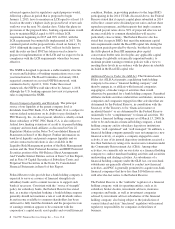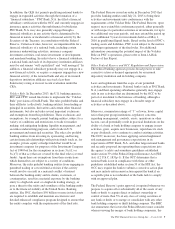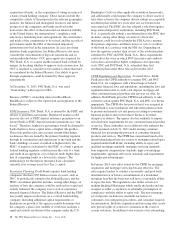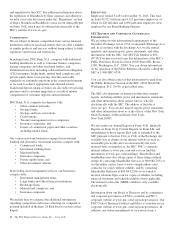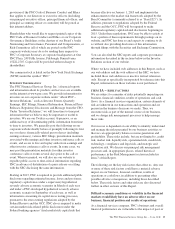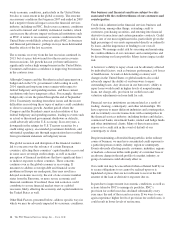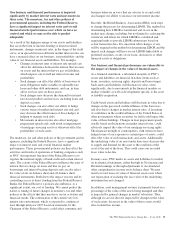PNC Bank 2013 Annual Report Download - page 23
Download and view the complete annual report
Please find page 23 of the 2013 PNC Bank annual report below. You can navigate through the pages in the report by either clicking on the pages listed below, or by using the keyword search tool below to find specific information within the annual report.
important non-bank financial companies designated by the
FSOC for Federal Reserve supervision. For bank holding
companies, these enhanced standards must be more stringent
than the standards and requirements applicable to bank
holding companies with less than $50 billion in assets, and
must increase in stringency for bank holding companies that
present heightened risk to the financial system. The FSOC
may make recommendations to the Federal Reserve
concerning the establishment and refinement of these
enhanced prudential standards. In February 2014, the Federal
Reserve issued final rules that establish the new enhanced
prudential standards related to liquidity risk management and
overall risk management. These new rules, which become
effective for PNC as of January 1, 2015, among other things,
require that covered bank holding companies conduct liquidity
stress tests at least monthly, maintain a contingency funding
plan and sufficient highly liquid assets to meet net stress cash-
flow needs (as determined under the company’s liquidity
stress tests) for 30 days, and establish certain oversight,
governance and reporting responsibilities for the chief risk
officer and risk committee of the Board of Directors of a
covered company. In addition, the new rules implement the
provisions of Dodd-Frank that require the Federal Reserve to
impose a maximum 15-to-1 debt to equity ratio on a bank
holding company if the FSOC determines that the company
poses a grave threat to the financial stability of the United
States and that the imposition of such a debt-to-equity
requirement would mitigate such risk. The rules issued in
February 2014 did not finalize the other enhanced prudential
standards that the Federal Reserve proposed in December
2011 for bank holding companies with $50 billion or more in
assets, including counterparty credit exposure limits and early
remediation requirements, although the Federal Reserve has
indicated that these matters remain under development. See
the Recent Market and Industry Developments portion of Item
7 MD&A and Item 1A Risk Factors for additional
information.
B
ANKING
R
EGULATION AND
S
UPERVISION
Regulatory Capital Requirements, Stress Testing and Capital
Planning. PNC and PNC Bank, N.A. are subject to the
regulatory capital requirements established by the Federal
Reserve and the OCC, respectively. These requirements are
currently the subject of significant changes as a result of the
rules adopted by the U.S. banking agencies in July 2013 to
implement the new international guidelines for determining
regulatory capital established by the Basel Committee on Bank
Supervision (Basel Committee) known as “Basel III,” as well as
to implement certain provisions of Dodd-Frank. The rules
adopted in July 2013 generally have three fundamental parts.
The first part, referred to as the Basel III capital rule, among
other things, narrows the definition of regulatory capital,
requires banking organizations with $15 billion or more in
assets (including PNC) to phase-out trust preferred securities
from Tier 1 regulatory capital, establishes a new Tier 1
common capital requirement for banking organizations, and
revises the capital levels at which PNC and the PNC Bank,
N.A. would be subject to prompt corrective action. These rules
also require that significant common stock investments in
unconsolidated financial institutions (as defined in the rule), as
well as mortgage servicing rights and deferred tax assets, be
deducted from Tier 1 common regulatory capital to the extent
such items individually exceed 10%, or in the aggregate
exceed 15%, of the organization’s adjusted Tier 1 common
capital. The Basel III capital rule also significantly limits the
extent to which minority interests in consolidated subsidiaries
(including minority interests in the form of REIT preferred
securities) may be included in regulatory capital. In addition,
for banking organizations, like PNC, that are subject to the
advanced approaches (described below), the rule includes
other comprehensive income related to both available for sale
securities and pension and other post-retirement plans as a
component of Tier 1 common capital. The Basel III capital
rule became effective on January 1, 2014, for PNC and PNC
Bank, N.A., although many provisions are phased-in over a
period of years, with the rules generally fully phased-in as of
January 1, 2019.
The second part of the rules adopted in July 2013 is referred to
as the advanced approaches and materially revises the
framework for the risk-weighting of assets under Basel II. The
Basel II framework, which was adopted by the Basel
Committee in 2004, seeks to provide more risk-sensitive
regulatory capital calculations and promote enhanced risk
management practices among large, internationally active
banking organizations. The advanced approaches
modifications adopted by the U.S. banking agencies became
effective on January 1, 2014, and generally apply to banking
organizations that have $250 billion or more in total
consolidated assets or that have $10 billion or more in on-
balance sheet foreign exposure. Prior to fully implementing
the advanced approaches to calculate risk-weighted assets,
PNC and PNC Bank, N.A. must successfully complete a
“parallel run” qualification phase. PNC and PNC Bank, N.A.
entered this parallel run qualification phase on January 1,
2013. This phase must last at least four consecutive quarters,
although, consistent with the experience of other U.S. banks,
we currently anticipate a multi-year parallel run period.
The third major part of the rules adopted in July 2013 is referred
to as the standardized approach and materially revises the
framework for the risk-weighting of assets under Basel I. The
standardized approach, for example, establishes a new
framework for the risk-weighting of securitization and non-U.S.
sovereign exposures, and increases the risk-weights on certain
types of assets including high-volatility commercial real estate
and past due corporate and retail exposures. The standardized
approach will become effective on January 1, 2015.
The risk-based capital and leverage rules that the federal
banking regulators have adopted require the capital-to-assets
ratios of banking organizations, including PNC and PNC
The PNC Financial Services Group, Inc. – Form 10-K 5



